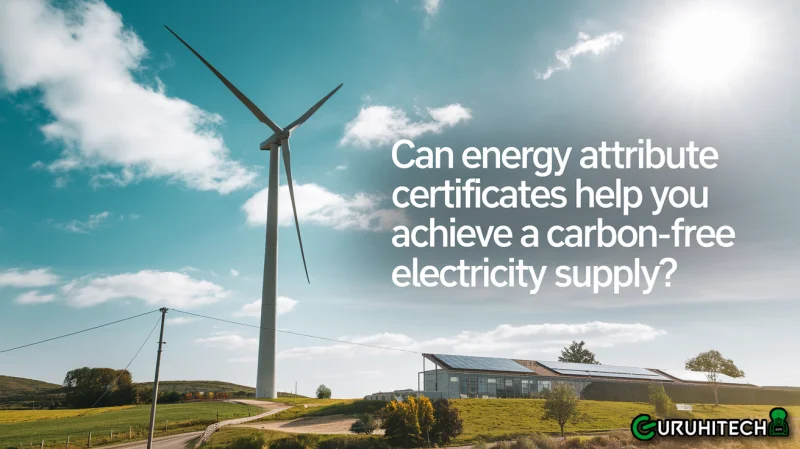Can Energy Attribute Certificates Help You Achieve a Carbon-Free Electricity Supply?

Many businesses strive to provide carbon-free energy in their quest for sustainability. Energy Attribute Certification (EAC) is a tool that can be used to prove the use of renewable energy. This article will explore how EACs help businesses reduce carbon footprints and contribute to a future free of carbon.
What Are Energy Attribute Certificates?
Energy Attribute Certificates represent environmental attributes of renewable energy generation. One EAC is equal to one megawatt hour (MWh) produced by renewable sources like solar, wind or hydropower. The certificates can either be “bundled” along with the sale or electricity, or “unbundled”, and sold separately. If a company retires its EAC and claims that the electricity they consumed was renewable, this reduces their scope2 emissions. These are indirect greenhouse gas emission associated with electricity usage.
How EACs Help Reduce Scope 2 Emissions?
EACs are primarily used to reduce scope 2 emissions. These indirect emissions result from electricity consumption. A business that purchases EACs can claim to be using renewable energy, even if it uses conventional electricity for its operations. The owner can reduce its emissions after retiring the EAC by matching its renewable electricity attributes with its actual consumption.
EACs are a way for businesses to show their commitment to renewable energies and to report this reduction in sustainability frameworks like the Greenhouse Gas Protocol or RE100.
Types of Energy Attribute Certificates
Based on regional and global standards, there are different types of Certificates for Energy Attributes. Some of the most widely recognized include:
- Guarantees of Origin (GOs): Commonly used in Europe.
- Renewable Energy Certificates (RECs): Primarily used in the United States.
- International Renewable Energy Certificates (I-RECs): Applicable globally.
- TIGRs (Tradable Instruments for Global Renewables): Also globally available.
These EACs all function in a similar way, allowing businesses the opportunity to reduce their carbon footprint by purchasing renewable energy. The certificates are tracked by systems that prevent double-counting, so that the environmental benefits from renewable energy can only be claimed once.
EACs vs. Carbon Credits: What’s the Difference?
It is important to differentiate EACs and Carbon Credits. Carbon credits are reductions in greenhouse gases, usually from projects that have nothing to do with a company’s business value chain. EACs, on the other hand, are a claim of using renewable electricity as part of an organization’s business value chain. EACs demonstrate that CFE carbon free electricity used was renewable. Carbon credits, on the other hand, are offsets of emissions from elsewhere.
Considerations for Buying EACs
It is not easy to buy Energy Attribute certificates. There are important factors to consider, such as:
- Market Boundaries: EACs are best sourced in the region or country where electricity is consumed. A business in Colombia would be wise to buy EACs produced in Colombia as claims from across the border may not be accepted.
- Vintage: It is important to consider the time at which an EAC was created. To ensure relevancy, it’s best to match the EAC generation period with the electricity consumption time.
- Technology: Costs for different renewable energy sources can vary. Due to high demand, solar and wind EACs are more expensive.
Ensuring Credibility with EACs
In order for a company’s claim to be credible, they must adhere to international standards, such as Greenhouse Gas Protocol CDP and Re100. These frameworks guarantee that EACs meet strict criteria of environmental integrity. If these guidelines are not followed, claims can be made that lack credibility and harm the sustainability reputation of a company.
High-Impact EACs for Greater Sustainability
EACs with high impact can be used by companies who want to go beyond compliance. They contribute to global sustainability initiatives. EKOEnergy Label, for example, allocates a part of proceeds from EACs sales to fund renewable projects in developing nations. DRECs support small-scale projects in emerging markets. They have a positive impact on the environment and socially.
Conclusion: EACs as a Pathway to Carbon-Free Electricity
Energy Attribute certificates are a flexible, credible and cost-effective way for businesses to achieve a carbon-free electric supply. EACs are a vital tool for the transition to renewable energies because they reduce scope 2 emissions, and comply with international sustainability standards. To ensure that EACs are of the highest quality, it is important to consider market boundaries, technology, and vintage. Source high-impact EACs for organizations that are committed to making a deeper impact. This can help them make a greater contribution to achieving a sustainable future.
Ti potrebbe interessare:
Segui guruhitech su:
- Google News: bit.ly/gurugooglenews
- Telegram: t.me/guruhitech
- X (Twitter): x.com/guruhitech1
- Bluesky: bsky.app/profile/guruhitech.bsky.social
- GETTR: gettr.com/user/guruhitech
- Rumble: rumble.com/user/guruhitech
- VKontakte: vk.com/guruhitech
- MeWe: mewe.com/i/guruhitech
- Skype: live:.cid.d4cf3836b772da8a
- WhatsApp: bit.ly/whatsappguruhitech
Esprimi il tuo parere!
Ti è stato utile questo articolo? Lascia un commento nell’apposita sezione che trovi più in basso e se ti va, iscriviti alla newsletter.
Per qualsiasi domanda, informazione o assistenza nel mondo della tecnologia, puoi inviare una email all’indirizzo [email protected].
Scopri di più da GuruHiTech
Abbonati per ricevere gli ultimi articoli inviati alla tua e-mail.
